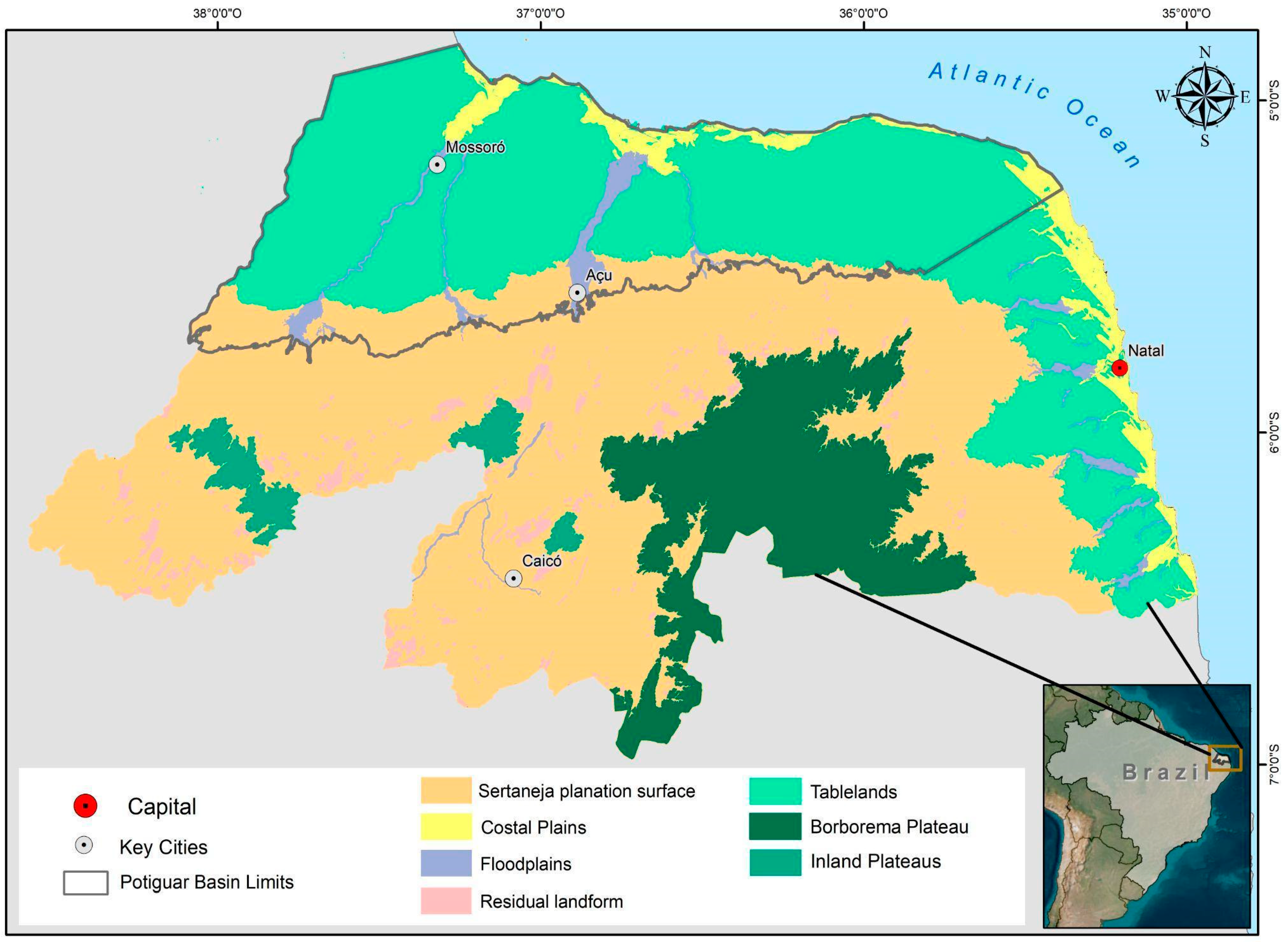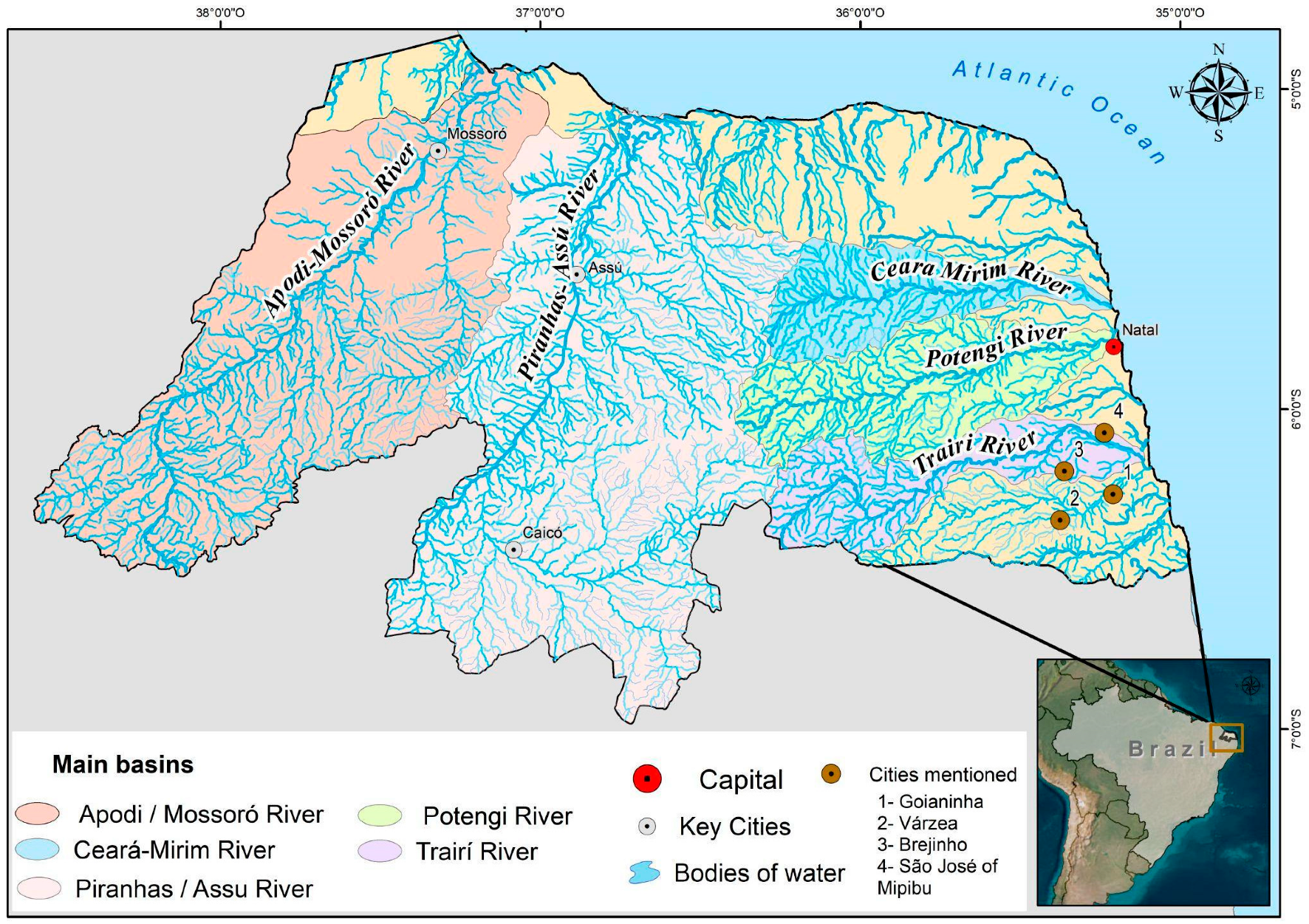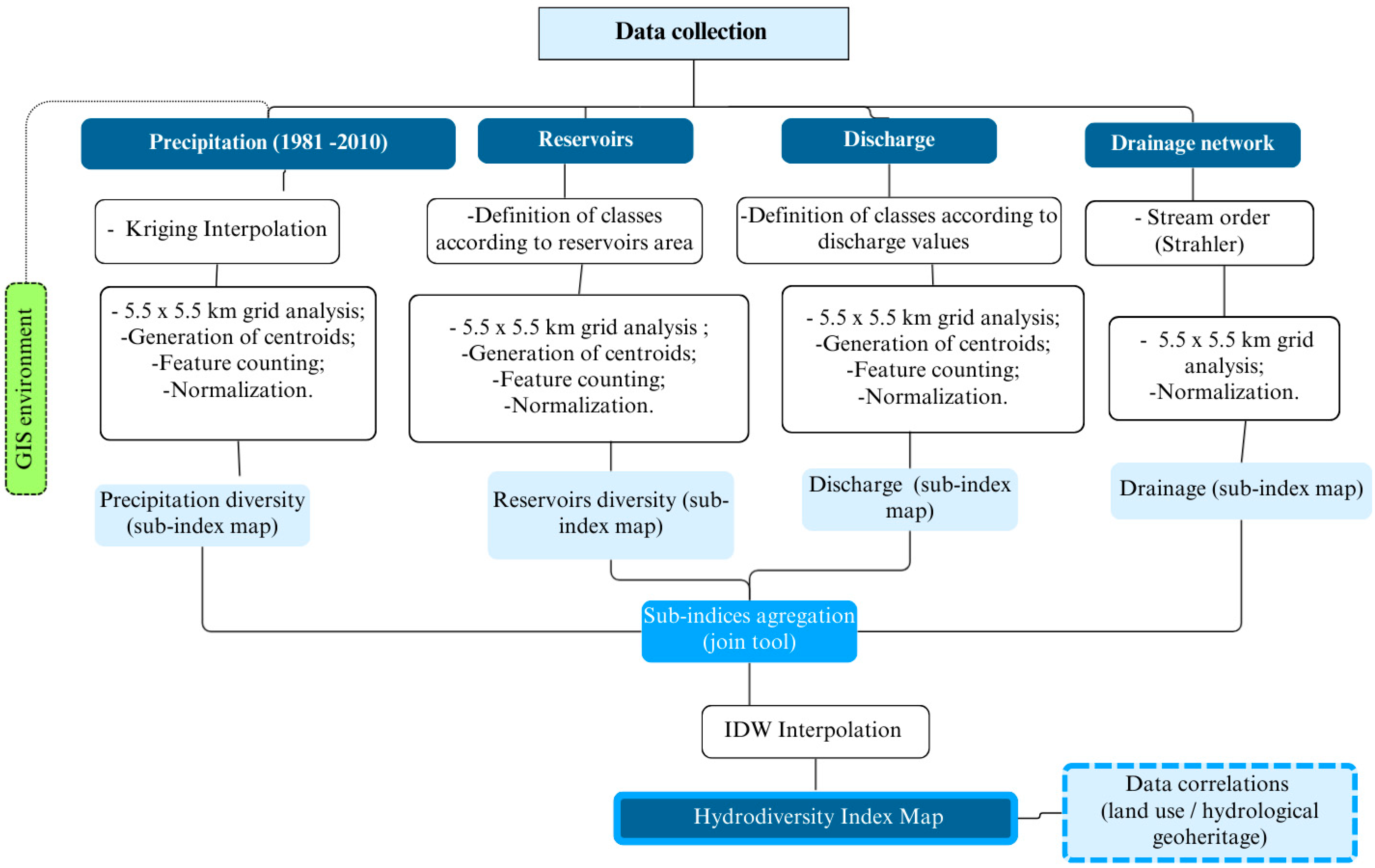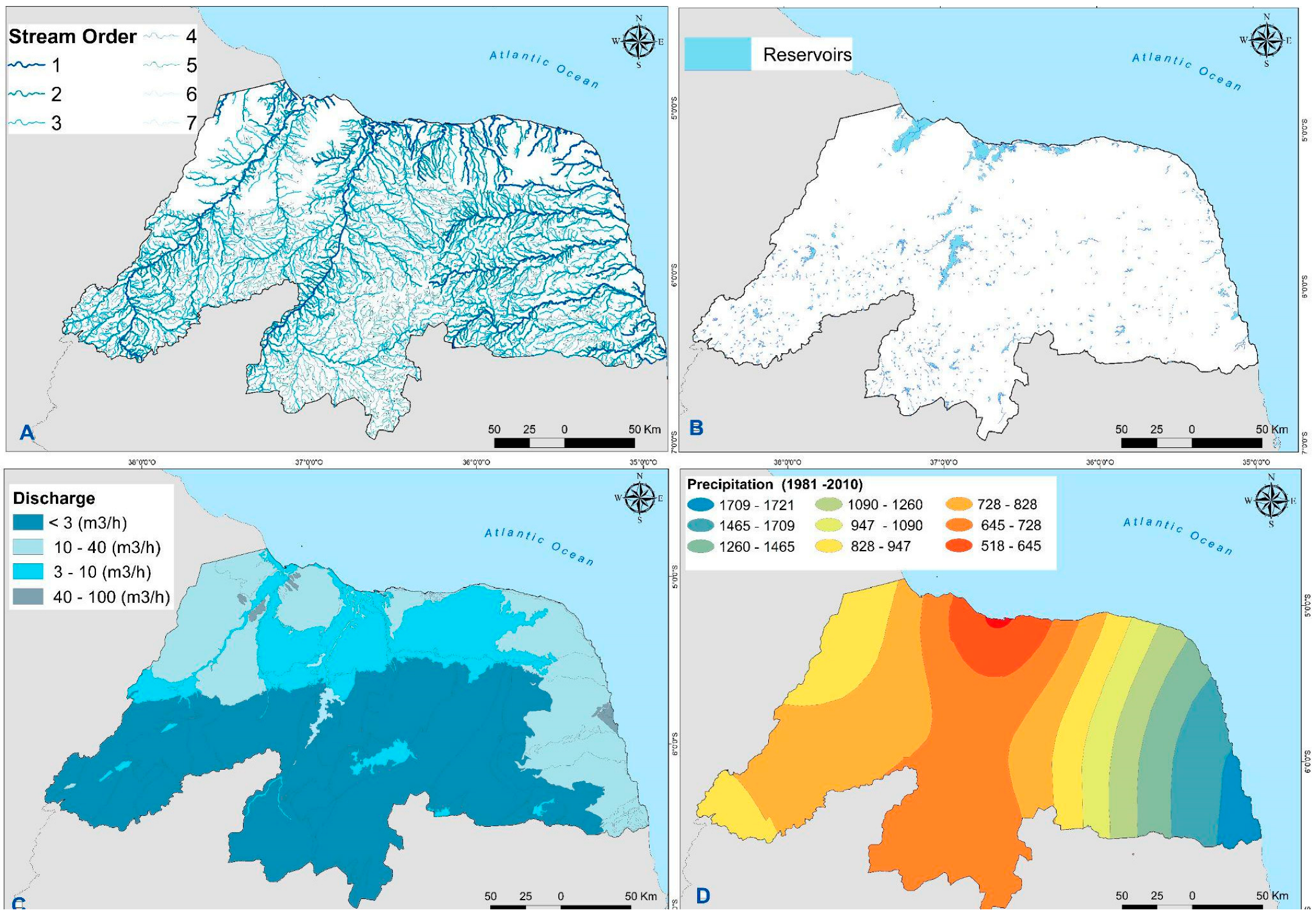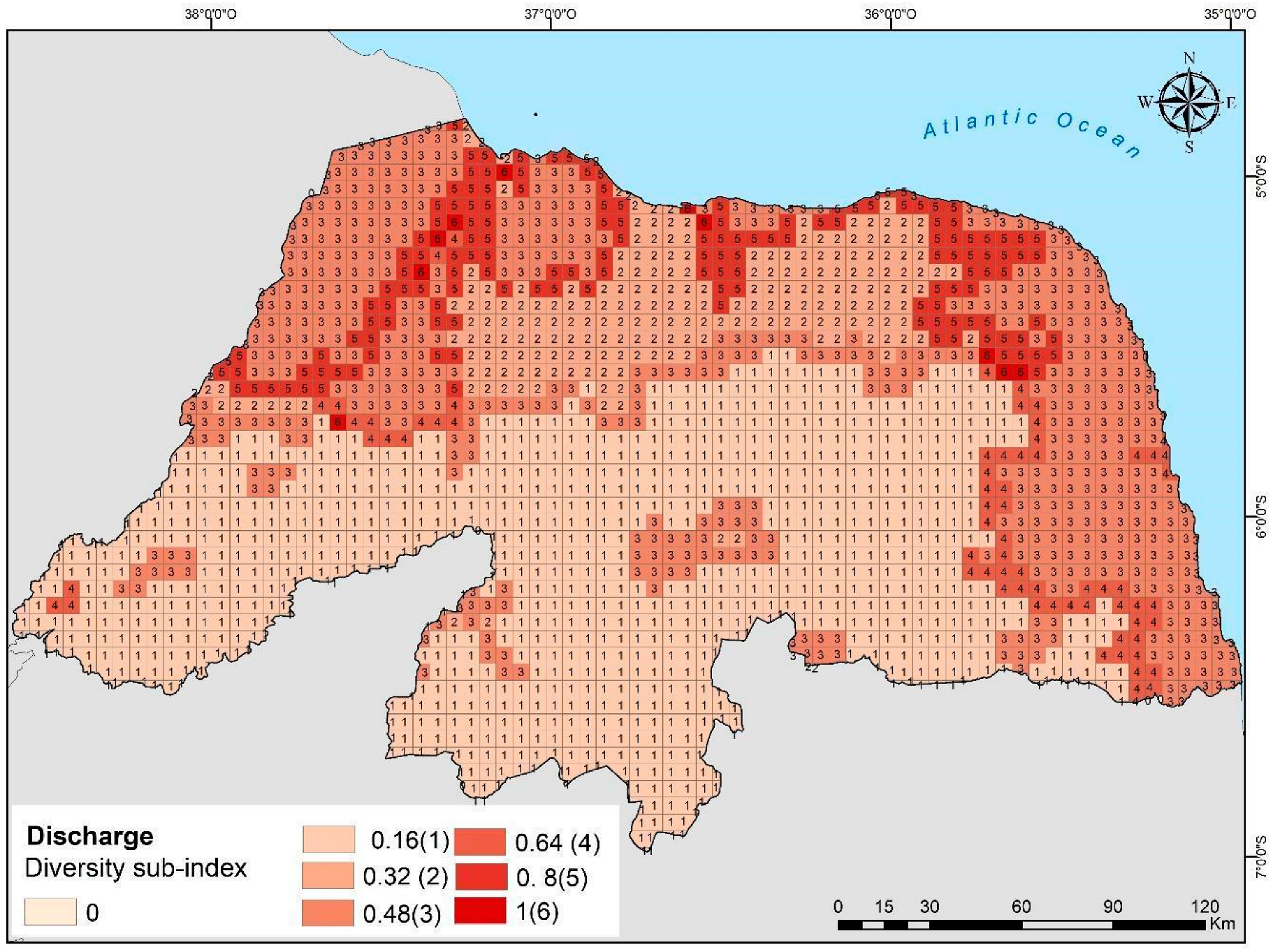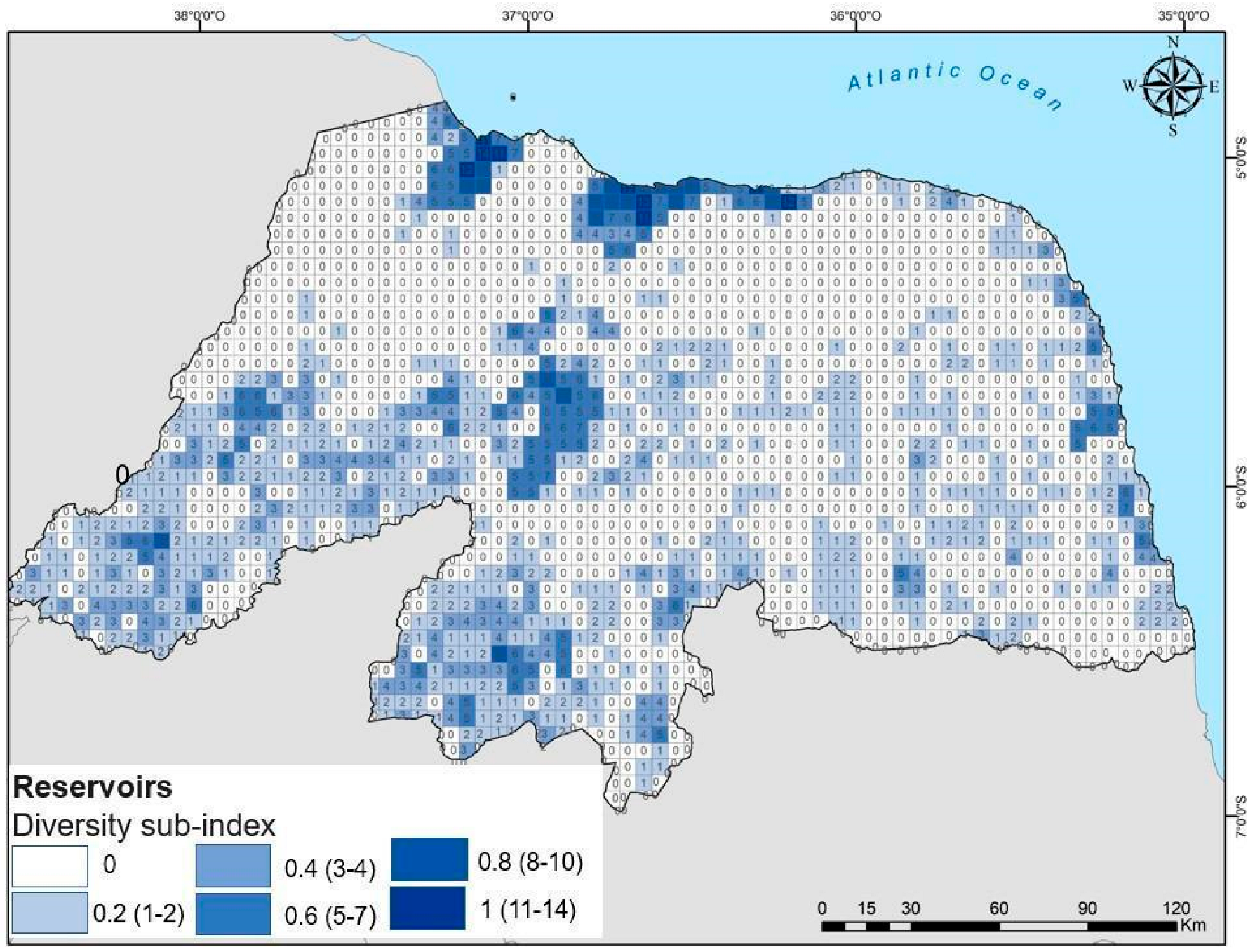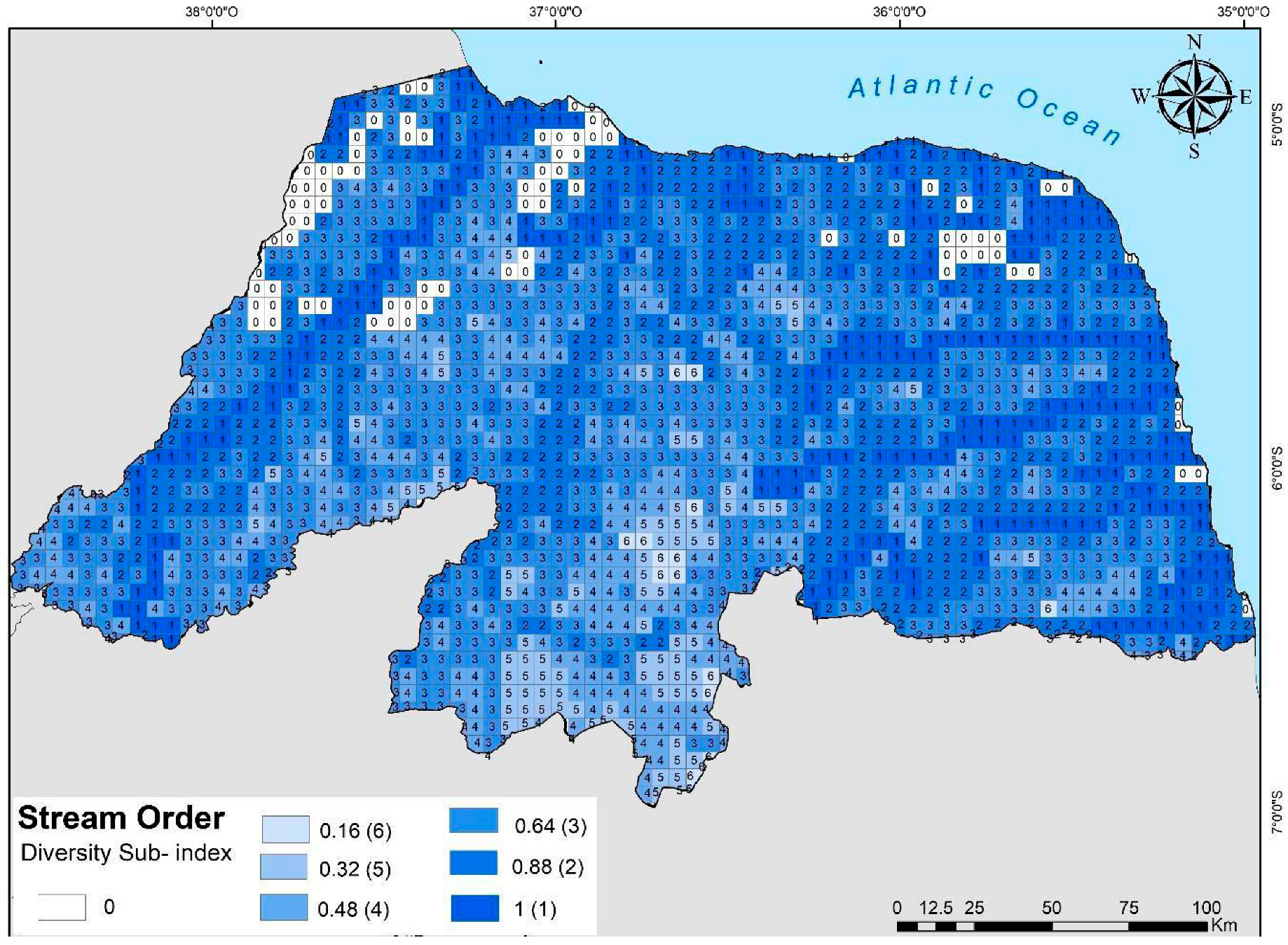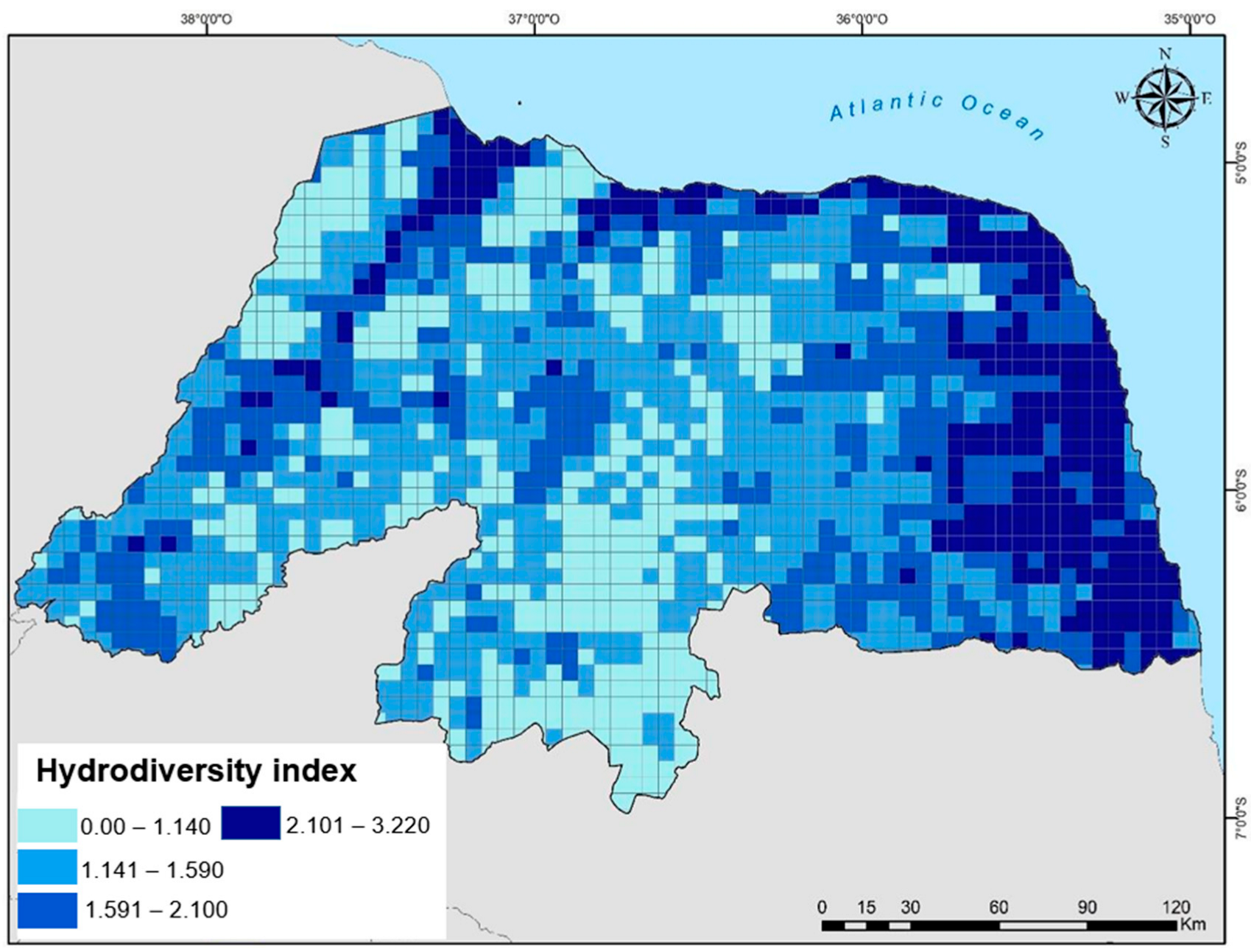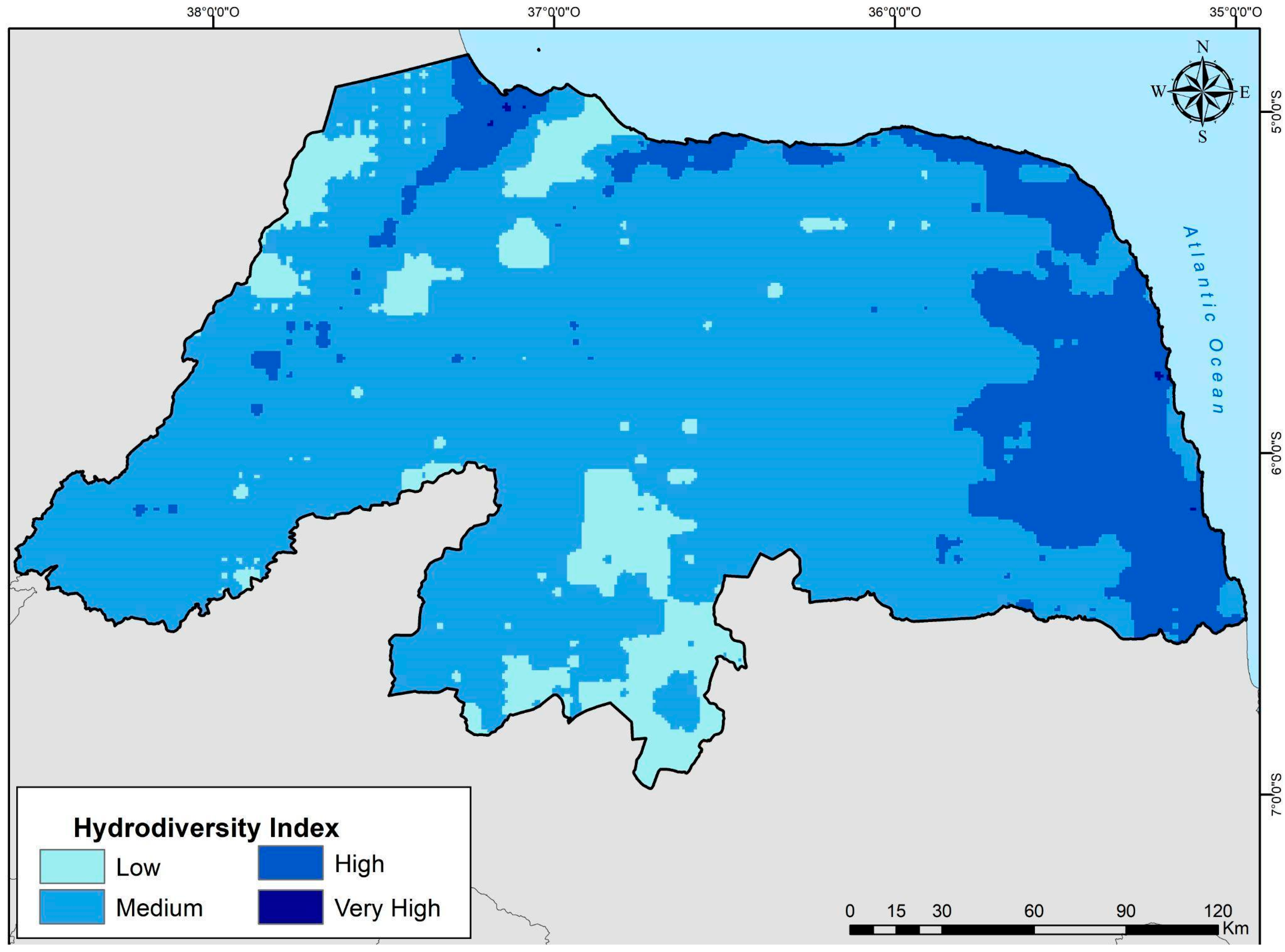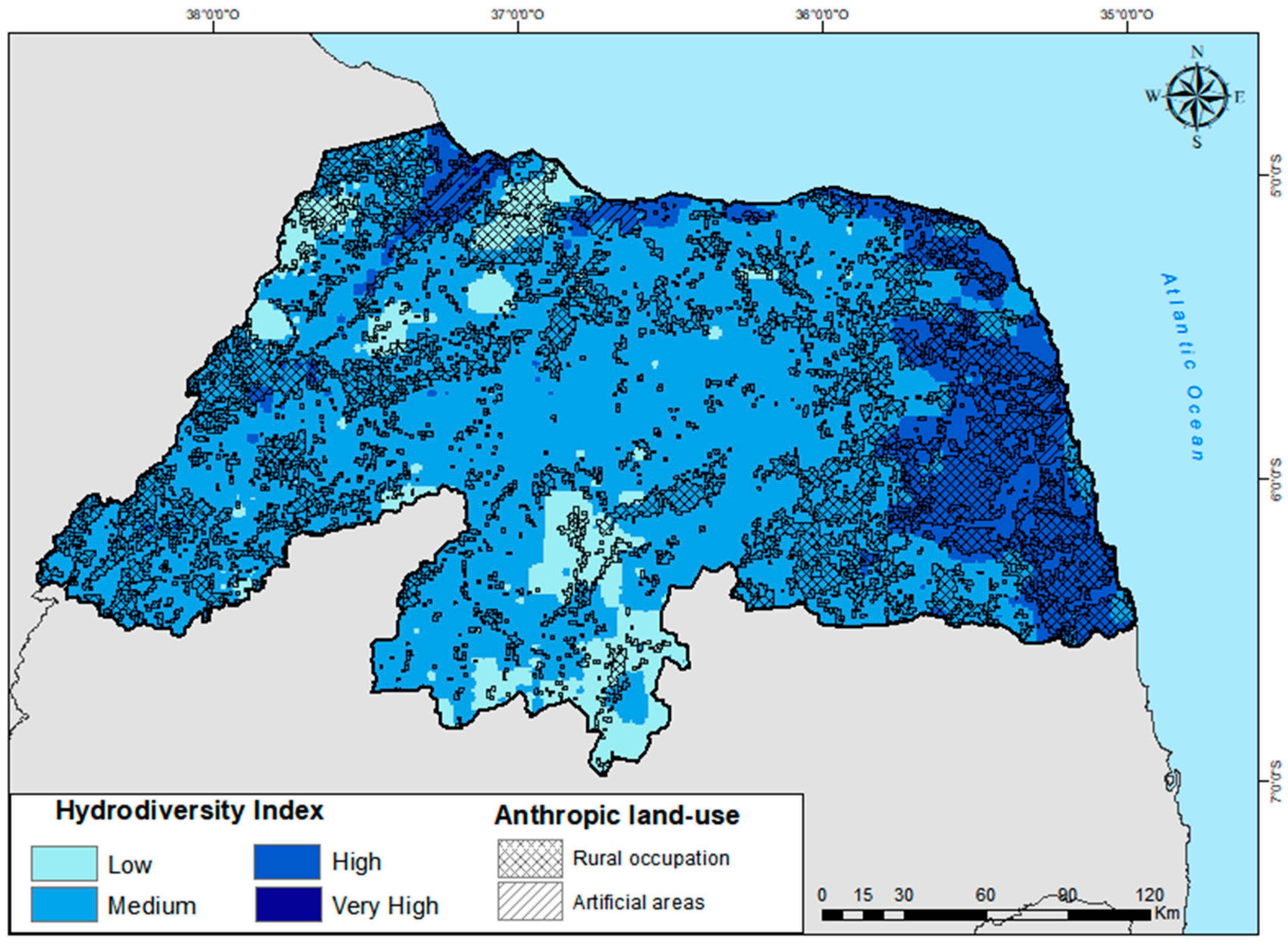1. Introduction
The study of geodiversity involves developing approaches for understanding, valuing, and promoting the sustainable use of the Earth’s abiotic components. Conceptually, it encompasses geological, pedological, hydrological, and geomorphological features, as well as the structures and systems that shape landscapes [
1]. Water, as an integral element of geodiversity, plays a crucial role in terrestrial processes. Its effective management relies on its interaction with other abiotic elements, all of which possess intrinsic value and are linked to broader societal demands [
2].
According to Brilha et al. (2018) [
3], geodiversity can be analyzed through two main perspectives, guided by central questions such as “What?”, which pertains to identifying the types and spatial distribution of geodiversity elements in a given area. Within this framework, hydrology is emphasized as the principal aspect of geodiversity examined in the present study. Hydrological diversity (hydrodiversity) refers to the variety of hydrological features within a given region, including rivers, lakes, aquifers, and other surface and subsurface water bodies [
4]. This diversity of water resources is key to sustaining life and maintaining environmental balance, and it is a part of geodiversity, which encompasses all the components of abiotic nature.
Instead, geoheritage refers to the subset of geodiversity features that are considered to have significant scientific, cultural, aesthetic, ecological, or tourism value. In this context, some hydrological features can be considered as geoheritage and are referred to as hydrological heritage [
4]. The identification, evaluation, and conservation of these sites (Hydrosites) are essential for promoting the sustainable and responsible use of water resources.
To this end, objective assessment methodologies to assess geodiversity have become necessary to inform conservation efforts, spatial planning, and environmental management [
5]. According to Gonçalves et al. (2022) [
6], widely adopted quantitative methodologies are based on map analysis and the use of indices. These geodiversity indices are derived from the integration of data related to geology, geomorphology, soils, water resources, and other relevant variables.
Recent studies have also focused on hydrological geoheritage, identifying sites with scientific value, which consider criteria such as representativeness, integrity, rarity, and scientific knowledge. From this framework, several hydrosites were identified and quantitatively assessed in the Rio Grande do Norte state, in Brazil [
7], the study area for this research. Similarly, geoconservation strategies were proposed for waterfalls in the central region of the state [
8]. By combining the 15 hydrosites inventoried in these previous studies with seven additional sites identified using the same assessment methodologies [
7,
9], a total of 22 hydrosites were recognized in the study area.
Furthermore, a geodiversity assessment conducted across the entire state [
10] was considered, which produced an index that incorporates geological, hydrological, geomorphological, pedological, and mineral resource variables. Even though this work did not focus on a detailed assessment of hydrodiversity nor involved the identification of hydrosites, it was considered as a reference to compare the results regarding the hydrodiversity of Rio Grande do Norte state.
Therefore, the guiding question for our study is whether a Hydrodiversity Index can be used to identify hydrosites or if their occurrence can be linked to specific patterns of hydrodiversity. Accordingly, the main objective is to calculate a Hydrodiversity Index using selected hydrological variables and to compare the resulting spatial patterns with the distribution of the 22 previously identified hydrosites. Other goals are to compare the Hydrodiversity Index results with (i) the geodiversity index applied by Dias et al. [
10] and (ii) the land use in Rio Grande do Norte state [
11].
Unlike previous studies on geodiversity and geoheritage, which typically address water resources as one of several variables, this research focuses specifically on hydrological features of geodiversity. By applying a Hydrodiversity Index and correlating it with hydrological heritage, the study seeks to advance the understanding of water-related features within the broader framework of geodiversity. This targeted approach allows for a more detailed assessment of hydrological elements, trying to contribute to geoheritage research by treating water resources as a distinct and significant focus of analysis.
The 22 hydrosites inventoried in Rio Grande do Norte fall into four categories: waterfalls, lagoons, springs, and thermal springs. Considering the diverse characteristics of the region, the results of this study can contribute to the development of geoconservation strategies, which may also be adapted for application in other regions. From a geological perspective, the study area has distinct characteristics, with water resources located in a semi-arid environment and rivers that are generally intermittent and low-flowing. The primary rivers include the Piranhas–Açu, Apodi–Mossoró, and Potengi. Due to the combination of climatic constraints and social water management challenges, this region faces persistent difficulties in ensuring sustainable water use [
11].
3. Results
3.1. Sub-Indices
3.1.1. Precipitation Diversity Sub-Index
The precipitation diversity sub-index map was generated from annual rainfall data collected over thirty years (1981–2010) and interpolated within a GIS environment (
Figure 5). This map provides a spatial representation of the state, highlighting the stark contrast in precipitation levels between the eastern coastal region and the central interior of Rio Grande do Norte.
3.1.2. Discharge Diversity Sub-Index
With the discharge diversity sub-index ranging from 1 to 6 points, the highest values are primarily concentrated in areas where major rivers converge, particularly in the middle and lower reaches of the Apodi–Mossoró River basin. These elevated values are especially prominent throughout the Potiguar basin (
Figure 6).
3.1.3. Reservoirs Diversity Sub-Index
The high concentration of reservoirs in the south-central and southeastern regions of Rio Grande do Norte (
Figure 4B) reflects the state government’s strategy to address local water demands, particularly in areas where climatic and geographical conditions restrict access to broader water sources. In these regions, small reservoirs—typically less than 400 hectares in size—predominate and primarily serve water supply functions.
In contrast, larger reservoirs, such as the Armando Ribeiro Gonçalves Dam—the largest in the state, located in the Assú Valley River (
Figure 2)—play a critical role in supporting multiple uses, including irrigation, water regulation, and drought mitigation. Similarly, the estuarine systems along the northern coast, due to their representativeness and size, contribute significantly to hydrological regulation and environmental balance, while also serving as areas of ecological and economic relevance. These regions, therefore, exhibit the highest values in the reservoirs diversity sub-index (
Figure 7).
The variation in reservoir size and function reflects adaptation to the natural characteristics and specific water demands of each region, illustrating both human interventions to enhance water availability and the strategic importance of large-scale infrastructure for the water sustainability of Rio Grande do Norte. Additionally, the Potiguar basin contains relatively few reservoirs, primarily due to the presence of groundwater wells, extremely flat terrain unsuitable for dam construction, and the high permeability of local rock formations.
3.1.4. Stream Order Diversity Sub-Index
The stream order diversity sub-index reflects the hierarchical organization of surface water networks across the state. The final map reflects the existence of principal river channels throughout all regions of Rio Grande do Norte (
Figure 8), with particular prominence in the Piranhas–Açú and Ceará-Mirim basins (
Figure 2), situated in the central area, as well as in the river mouth areas along the entire eastern coastline. However, certain areas remain unmapped in terms of drainage, particularly in regions characterized by diffuse surface flow, such as northeastern Rio Grande do Norte and the northern boundary with the state of Ceará.
3.2. Hydrodiversity Index
The Hydrodiversity Index, which integrates the interaction among the aforementioned variables, enabled a detailed analysis of hydrological distribution across the study area. The normalization process, based on the MPV, resulted in final index values ranging from 0.38 to 3.22 out of a possible 4. This adjustment facilitated the integration of variables without disproportionately emphasizing any individual component (
Figure 9).
The highest index values were primarily concentrated along the eastern coast (
Figure 9), particularly in the municipalities of Goianinha, Várzea, Brejinho, and São José de Mipibu (
Figure 2). This pattern is attributed to a favorable combination of factors, including high rainfall and a denser drainage network, which together enhance water availability. Historically, this region has been characterized by sugarcane cultivation, an activity that relies heavily on both water availability and fertile soils.
Additionally, high index values were observed along the Apodi–Mossoró River, in the western part of the study area, reflecting the interplay between the river’s high stream order and the presence of a dense distribution of smaller reservoirs in its upper reaches and more prominent reservoirs downstream. This pattern underscores the importance of an integrated approach for understanding the interactions among hydrological variables and their influence on regional water dynamics.
The analysis revealed that the majority of the state falls within the medium-value category of the Hydrodiversity Index. The use of IDW interpolation significantly enhanced the visualization of spatial patterns, enabling clearer interpretation of the index’s distribution (
Figure 10).
3.3. Hydrodiversity and Land Use
Two categories of anthropogenic land use—rural occupation and artificial areas—were incorporated into the analysis (
Figure 11). A comparison between Hydrodiversity Index values and land use patterns indicates that high-value areas are predominantly located in regions with significant rural and artificial occupation, particularly along the eastern coast. This region serves as the state’s industrial hub, notably for the textile, food processing, and sugarcane sectors.
On the northern coast, where economic activities focus on shrimp farming and salt production, high-value Hydrodiversity Index zones were also identified in association with anthropogenic land use, particularly in estuarine areas. In contrast, the central region is characterized by more dispersed rural occupation and an economy centered on livestock farming. This area exhibits a lower frequency of high or very high index values, which appear only sporadically. In the western region, however, high-value rural settlements are present, reflecting the region’s predominantly agricultural character.
Overall, this analysis highlights the strong relationship between land use and the distribution of hydrodiversity in Rio Grande do Norte. It demonstrates how economic activities—particularly rural activities—and human settlement patterns are closely influenced by hydrological environmental dynamics (
Table 4). 67.27% of the Artificial areas correlate with the High Hydrodiversity class, while Rural areas correlate predominantly with Medium (64.38%) and High Hydrodiversity (27.97%) classes. Distinct contrasts emerge between the eastern coastal zone, characterized by higher rainfall, and the interior of the state, marked by arid conditions and dependence on reservoirs for water storage. The prominence of rivers such as the Apodi–Mossoró, which flows through the Apodi Plateau, further illustrates areas of high hydrodiversity along its course to the river mouth.
3.4. Hydrodiversity and Hydrological Geoheritage
The 22 hydrosites inventoried in the state are mainly concentrated in three regions (
Table 5 and
Figure 12). In the northwestern region of the state (
Figure 12A), the hydrosites are primarily located along the course of the Apodi–Mossoró River, which includes a hot spring in the city of Mossoró and two waterfalls. The hot spring occurs in a high Hydrodiversity area, while the waterfalls are in Medium Hydrodiversity areas (
Figure 12A). In the southwestern region (
Figure 12C), five hydrosites occur in Medium Hydrodiversity areas and one in a Low Hydrodiversity area. On the eastern coast (
Figure 12B), 11 of the 13 hydrosites are in High Hydrodiversity areas, with the other two located in Medium Hydrodiversity areas.
These results seem to establish a correlation between the occurrence of hydrosites and areas of greater hydrodiversity. More than 50% of hydrosites occur in areas of high hydrodiversity and 95.5% of them in areas of medium or high hydrodiversity. However, these data must be interpreted with some caution, as these high percentages are in the same order of magnitude as the area occupied by these classes of hydrodiversity, which is more than 90% of the entire state. Similarly, there is not a single hydrosite located in an area of Very High Hydrodiversity, and there is only one hydrosite in an area of Low Hydrodiversity.
Therefore, the findings may expose the fragility of an approach that compares diversity with scientific value of hydrological features, which were assessed using different criteria.
4. Discussion
4.1. Hydrodiversity of Rio Grande do Norte
When considering the results obtained by Dias et al. (2021) [
10] on the geodiversity of Rio Grande do Norte, a notable homogeneity across the territory is observed, including in relation to hydrographic elements. In their study, regions with high and very high indices were identified in areas of lithological contact, geomorphological transitions, and mineral occurrences. A comparison between the hydrographic diversity sub-index presented by Dias et al. (2021) [
10] and the final geodiversity index of their study reveals differences in the spatial distribution of results, as the latter incorporates additional variables. Specifically, in some areas—particularly around the Apodi–Mossoró River and in the central and northern regions—scores were not assigned in the hydrographic diversity sub-index and are represented with a value of zero, due to the absence of rivers or bodies of water. Nevertheless, many of these areas have water representation, albeit low, which is not captured by a single sub-index.
In our study, the hydrological sub-index proposed by Dias et al. (2021) [
10] was employed as a starting point to understand the water-related issues in Rio Grande do Norte state. A more in-depth methodology, capable of encompassing different aspects of hydrodiversity could significantly enhance the detail of the assessment and become important for an integrated assessment of water resources.
As suggested by Dias et al. (2021) [
10], further studies on cartographic elements and the development of specific sub-indices are essential in this matter. In this context, the Hydrodiversity Index presented in this study broadens the understanding of territorial complexity by incorporating hydrological variables that emphasize regional differences. The significance of diverse and available cartographic data related to hydrological elements is paramount. This study was able to acquire information on key hydrological variables, including average annual rainfall, discharge, hydrographic networks, and water bodies of varying sizes. It is important to note that the inclusion of additional variables, should the relevant data be available, would enable a more comprehensive analysis of water diversity.
In general, the Hydrodiversity Index presented appears to be a reliable indicator of water resource diversity and availability within the state. In addition to highlighting the representativeness of estuaries on the northern and eastern coasts, as well as inland water bodies, the index incorporates variables such as precipitation and discharge, which highlight the highest hydrodiversity values along the eastern coast and within the Apodi–Mossoró River drainage basin.
4.2. Hydrodiversity vs. Hydrological Heritage
Dias et al. (2021) [
10] highlighted specific areas with a high geodiversity index, which were associated with geosites of heritage value. One of the primary objectives of the present study was to identify if the same observation could be performed specifically for the hydrological features of geodiversity and geoheritage.
Along the eastern coast of Rio Grande do Norte, numerous springs are located in palaeodunes, near areas exhibiting High Hydrodiversity values. Similarly, waterfalls in the western region are situated near the contact between the Serra de Martins Formation and the crystalline basement. In contrast, the estuaries of the Potengi and Piranhas–Açú rivers—both of which exhibit very High Hydrodiversity—do not host any identified hydrosites. Of the 22 hydrosites, 12 are located in areas with a high Hydrodiversity Index, while the remaining 10 hydrosites are found in areas with medium or low index values (
Table 5 and
Figure 12). However, it must be considered that High and Medium Hydrodiversity areas correspond to more than 90% of the total area of the state, which correlates with the occurrence of hydrosites in these areas. Moreover, there are no hydrosites located in Very High Hydrodiversity areas while one hydrosite is located an area of Low Hydrodiversity.
The methodology to set the hydrodiversity classes was based on the sum of the four normalized sub-indices, as presented in
Table 3. Very High Hydrodiversity class contains scores ranging from 3 to 4, what occurs only in restricted areas of the study region. Nevertheless, it must be stated that the IDW interpolation, although it is a tool that allows results to be made more objective and less locally biased, it can have a decisive influence on the definition of these classes. Without this interpolation, there would be more areas with Very High Hydrodiversity and, therefore, more hydrosites corresponding to this category.
The findings show that the proposed Hidrodiversity Index is useful to identify hotspots of water resources diversity based on the parameters used, although it seems to have limitations to establish connections between these areas and the actual occurrence of hydrosites. This suggests that hydrological heritage can occur independently of quantity of water resources.
Moreover, the criteria used to assess geoheritage and geodiversity differ, resulting in divergent, uncorrelated outcomes. In geodiversity quantitative assessment, the goal is to identify the spatial distribution of certain elements by measuring the richness of occurrences per spatial unit. In contrast, the evaluation of geoheritage focuses on the value of these geodiversity elements, with an emphasis on scientific, ecological, cultural, and aesthetic value. While the high diversity of elements or processes may be a relevant criterion for assessing geoheritage, other criteria, such as rarity, may conflict with this approach, further underscoring the lack of correspondence between the two assessments.
4.3. Hydrodiversity vs. Land Use
The correlation between hydrodiversity and land use is particularly evident in areas with high values on the Hydrodiversity Index. Regions with high or very high hydrodiversity values have historically influenced land use and occupation patterns in Rio Grande do Norte. For example, human settlement in the Chapada do Apodi and Serra do Mel areas (north coast) is largely supported by the flow of wells used for irrigated agriculture. The mapping conducted reveals how hydrodiversity has shaped land occupation, with the exception of these two areas, which have seen recent expansion due to the drilling of extremely deep wells, some exceeding 500 m in depth.
On the north coast, which is focused on shrimp farming and salt production, high-value hydrodiversity spots associated with anthropic land use were identified. These areas correspond to infrastructure that supports these economic activities. In contrast, the central region has a more sparsely populated rural area, primarily engaged in livestock farming, and exhibits a lower incidence of high or very high Hydrodiversity Index values, which appear sporadically. In the Upper West, however, there is a concentration of high-value hydrodiversity in rural areas, reflecting the predominantly agricultural nature of this region. This analysis reinforces the relationship between land use and the distribution of the Hydrodiversity Index values.
4.4. Limitations of the Study
The quality of quantitative geodiversity assessment always depends on the quantity and quality of the cartographic information used as a basis for this analysis. Furthermore, this information should be in digital vector format to facilitate procedures in a GIS environment. This means that the results presented here could be improved if more cartographic data regarding water resources were available. Specifically, the lack of comprehensive information on river discharge across all basins, groundwater resources, and detailed data on evapotranspiration posed challenges to achieving more refined results. Given the territorial diversity of the region, these gaps impeded a more exhaustive analysis, limiting the potential for incorporating additional variables. Although the Hydrodiversity Index could benefit from incorporating additional variables, it remains a valuable tool to identify the distribution of water resources throughout Rio Grande do Norte. Future studies should incorporate more data in the analysis to enhance the level of detail and a more comprehensive characterization and distribution of these resources.
The absence of a relationship between hydrodiversity and hydrological heritage as it is interpreted here may also be related to the baseline data used. The use of other variables, especially those related to the value of water resources rather than their spatial distribution, may influence the results. It is also important to acknowledge that many of the areas with the highest hydrodiversity values correspond to regions with the highest levels of human occupation, which could contribute to the natural degradation of these areas. Furthermore, it should be recognized that Rio Grande do Norte’s hydrological heritage has not been fully inventoried, and there may still be unidentified sites that warrant further investigation. In this regard, the proposed index can serve as a useful tool in the ongoing effort to inventory hydrosites, particularly in less explored areas. In that sense, further scientific research is needed to identify sites of exceptional value, which should be incorporated into geoconservation efforts and inform the development of public policies aimed at the balanced use of this vital resource.
5. Conclusions
Despite limitations in the availability of cartographic data to support the analysis, the application of the Hydrodiversity Index to Rio Grande do Norte successfully demonstrated the distribution of water resources across the state. The geodiversity-based quantitative assessment methodology, specifically applied to hydrological features, produced relevant findings. By highlighting the contrast between the eastern and interior regions, the index emphasized the critical role of water as an essential resource for both environmental and territorial management.
While previous studies provided a comprehensive analysis of the state’s geodiversity, they presented limitations regarding specific components, such as hydrodiversity. To address this gap, a dedicated hydrodiversity index methodology was developed to refine the analysis. The use of automated procedures in a GIS environment proved valuable, enabling the identification of areas with varying levels of hydrodiversity within the study region.
These tools can support the formulation of public policies and management strategies. The results of the hydrodiversity index are applicable to integrated territorial planning, particularly in identifying priority areas for the conservation and sustainable use of water resources. This is especially relevant when high-hydrodiversity areas coincide with greater anthropogenic occupation, as observed in this study.
On the other hand, the relationship between hydrodiversity and hydrological heritage appears to be limited. The results indicate that the vast majority of hydrosites are located in areas of High Hydrodiversity, although these areas also represent much of the studied territory. Nevertheless, no hydrosites were identified in areas of Very High Hydrodiversity, while at least one hydrosite was found in an area of Low Hydrodiversity. In our view, and considering these data, the results should be interpreted with caution, though they also highlight the potential for further research. Future analyses could be conducted at the river basin scale, incorporating additional variables into the hydrodiversity assessment. Similarly, a more comprehensive inventory of the hydrological heritage of Rio Grande do Norte could include different levels of site significance—ranging from local to international—and examine the association of various hydrosite types (e.g., waterfalls, springs, lagoons, hot springs) with different hydrological environments.
